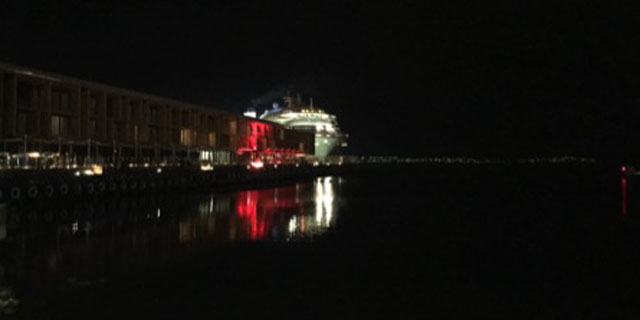Cruising into retirement
Ocean liner living

[Image: P&O attending the Dark Mofo cultural festival, Tasmania 2017, Simon Drysdale]
There has been a lot of chatter around the trend of going offshore, literally, as a retirement alternative to investing in traditional land ownership and/or integrated transitional care models. Access or not to multi-generational living steers this decision for many people.
The choice to cruise as explained by the Australian Financial Review (1) is informed by the fact that it is cheaper to continuously “cruise” than pay for conventional land-based retirement models. One thing that makes this option so beguiling is the service overlay with the existing retirement offer, such as the inclusion of health insurance and 24/7 nurse and doctor care into cruise fee structures.
This might free some discretionary income whilst cruising. But does it help the ‘coping unseen’ be seen? When travelling, a sense of security when you feel vulnerable is worth the purchase price. The emerging success of these floating enterprises highlights an engagement with a global economy and the increasing need to insure. On some international ocean liners, entire lower decks are devoted to sterile medical facilities and allied health services. Just like a regional community health centre, albeit on water.
One mainstream example, the ‘Carnival’, hosts 2024 passengers, is serviced by 903 crew and boasts 12 exterior decks of entertainment. Leisure activities include everything from dance floors to theatres, pubs, guest services, departure/arrival porte-cochere, library and internet facilities, wedding chapels to photographic studios and gallery shops.
Functionally, the terraces have anchor tenants such as fitness centres and beauty salons. Layered in between are steam and sauna rooms, food options, swimming pools, outdoor cinema, restaurants, bars, kid’s clubs, and mini golf. All surrounded by a running track. These individual leisure and retail experiences form an inverted shopping centre where promenade is sequential and legible.
This provides the effect of a familiar and comforting environment. However, the experience obscures the incumbent cost differences between ‘holiday’ and ‘retirement living’ modes which are characterised by retail immediacy. Compared to the wholesale, long-term, planned, negotiated and often bulk bought arrangements aligned with the status quo on land those who multi cruise throughout the year are rewarded with perks such as; complimentary linen services, non-surgical procedures, drink cards to entertain and the opportunity to customise the cruise apartment interior with personal furniture.
To cruise in comfort, security and with economy, the cruiser must accept that their adjacency, privacy and amenity will be challenged in ways that would not be acceptable in conventional medium to high density apartment developments. But the silver lining is in the random opportunities resulting from close neighbouring, sometimes through a design that engineers intentional regular encounters between friends and strangers (or new friends). The suspended and contained, but active and participatory nature of cruising gives some insight into why this option can be successful for those who board as individuals but seek shared experience and social inclusion.
Opportunities to globally migrate continue to expand for ‘snowbirds’ (2). But it is not all just about luxury. Regardless of budget, accommodation is about residing. It is about where and how we respite and this makes it intrinsically cultural. Residing and retiring, wherever we rest, becomes about our interfaces and our enclosures as our needs increase.
At Marchese Partners, we have been exploring and learning from these notions in practice and research. One example is from our work on what many consider to be a stationary cruise ship: Mark Moran Vaucluse. We’ve continued to explore these topics through design studios within the Master of Architecture, RMIT University and the soon to be released speculative research projects sited in Melbourne’s Southgate. Our discovery program is not singular. Instead we value iteration, narrative and episodic investigation.
If a cruise ship was a building it would be in a Multi-Age Precinct (M.A.P) and the outcome would facilitate person centred living. Multi-Age Precincts consider age diversity as critical for vitality and social sustainability. Why? Because a city is not only a collection of suburbs, it is a collection of stories.
- Australian Financial Review. April 12. 2017 ‘Grey cruising is making people – and cruise lines – rethink retirement living.’
- Snowbird: A snowbird is slang for a person who moves seasonally from cooler climates to warmer locations often associated with international cultural events.
[Source: Simon Drysdale, Principal, Marchese Partners Melbourne http://www.marchesepartners.com]